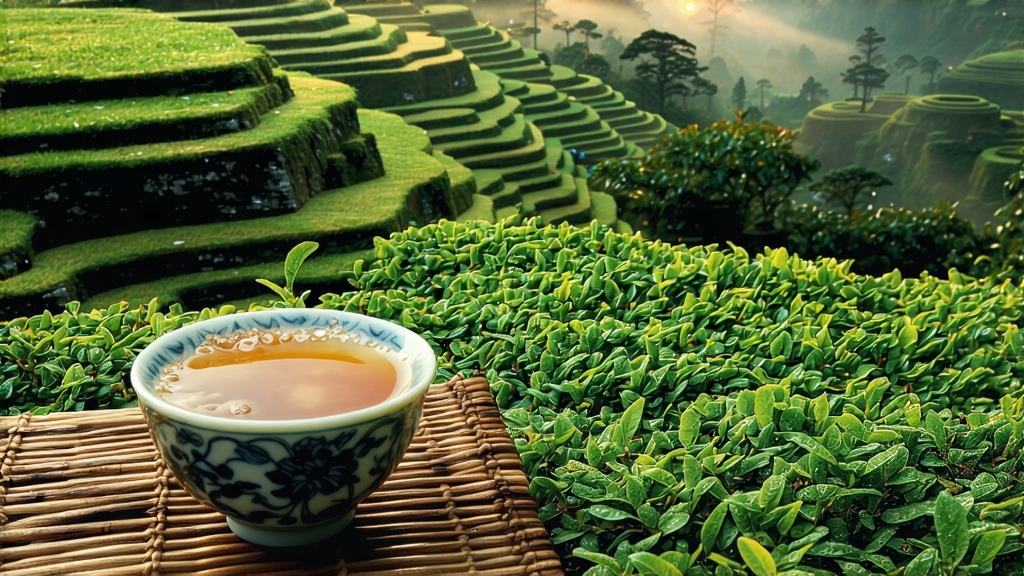
Alishan High-Mountain Oolong is the liquid echo of Taiwan’s central mountain range—an emerald thread spun between 1,000 and 1,400 metres above sea level where morning clouds stroke the camellia sinensis bushes until their leaf tips shiver with chilled sweetness. To international drinkers the name may sound lyrical yet vague, but inside Taiwan it signals the pinnacle of “gao shan cha”: high-mountain tea whose character is shaped less by human recipe than by altitude, diurnal temperature swings and the island’s legendary monsoon mist. In the cup it translates into a silky, milk-hued infusion that smells of mountain orchids and tastes like white peach dipped in mineral spring water, finishing with a cool, alpine breath that lingers on the back palate longer than many Burgundy whites.
Historical roots
Oolong itself was born along the rocky Fujianese coast during the Ming-Qing transition, yet Alishan’s story begins four centuries later, in 1980, when the Taiwanese Tea Research and Extension Station released the TTES #12 “Jin Xuan” cultivar. Farmers in Chiayi County grafted this hybrid—famous for its natural buttery note—onto Qing Xin cuttings that had migrated with the Kuomintang in 1949. The goal was not to replicate mainland Wuyi rock teas but to coax a new, soft style that could showcase Taiwan’s misty terroir. Within a decade Alishan spring teas were outselling Dong Ding in Taipei’s wholesale auctions, and by 1995 high-mountain oolongs had become the island’s most valuable agricultural export, eclipsing even premium mangoes.
Micro-terroir: why height matters
Alishan is not a single peak but a 300-km ridge system that intercepts both the northeast monsoon and the moist Pacific trades. Above 1,000 m the average temperature drops 0.6 °C for every 100 m gained, slowing leaf growth and thickening cell walls. The plant responds by boosting glutamic acid and fragrant geraniol, while ultraviolet intensity at altitude increases catechin but suppresses bitter tannins. The result is a leaf that is physiologically “tender” even when plucked at 20-day intervals—twice as long as lowland bushes—yielding a naturally sweet liquor that needs no added milk or sugar.
Plucking standard
Only the “three-leaves-and-a-bud” section is taken, usually between 10 a.m. and 2 p.m. when mountain dew has burned off but before afternoon fog re-wets the surface. Experienced pickers pinch rather than pull, keeping the tiny stipule intact; this prevents premature oxidation that would flatten the coveted floral layer. A full basket weighs barely 400 g, enough for about 60 g of finished tea after the 70 % moisture loss that follows eighteen hours of processing.
Crafting the semi-oxidised soul
Alishan Oolong is typically oxidised 20–30 %, lighter than traditional Dong Ding (35–40 %) but heavier than modern “green style” Baozhong (8–15 %). The craft unfolds in six acts:
- Solar withering: leaves are spread on bamboo trays under filtered mountain sun for 20 minutes, softening cells and initiating enzymatic activity.
- Indoor withering & tossing: every half-hour the leaves are gently tumbled in mesh drums, bruising edges just enough to invite oxygen while preserving the verdant centre. This dance lasts 6–8 hours and is judged by aroma alone—when the air smells like pear and hyacinth, the tea master moves on.
- Fixation: a 220 °C tumble-roast for 3 minutes kills the green enzymes, locking in the desired oxidation level.
- Rolling: the hot leaves are wrapped in cotton cloth and rhythmically compressed into tight hemispheres; pressure is released every 30 seconds to prevent bitterness. This step coaxes the signature “dragonfly head, toad leg” shape.
- Drying: a 90 °C conveyor bake reduces moisture to 4 %, stabilising the leaf for transport.
- Post-fermentation resting: the crude tea is stored for 30 days in paper-lined wooden crates so residual moisture migrates outward; this “annealing” harmonises flavour before final roasting.
Roasting spectrum
Consumers can choose between three roast profiles:
- Qing xiang (light, 70 °C for 2 hours): preserves j